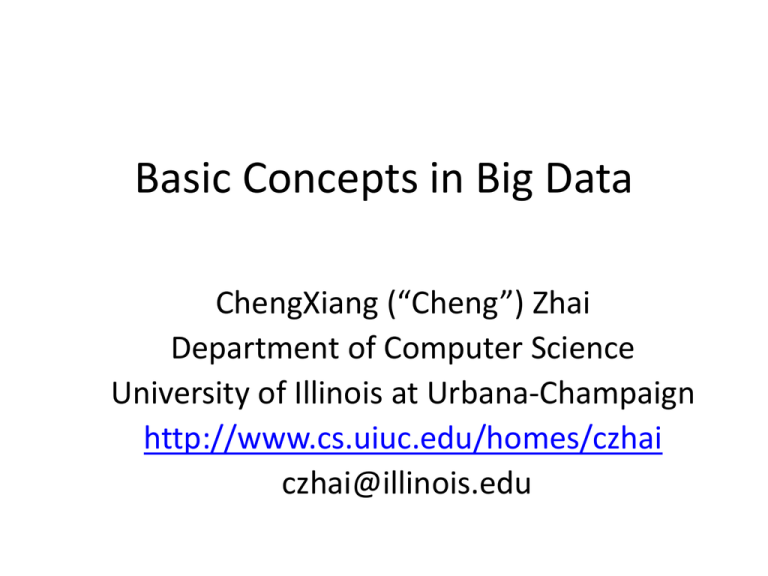intro-bigdata - University of Illinois at Urbana
advertisement

Basic Concepts in Big Data ChengXiang (“Cheng”) Zhai Department of Computer Science University of Illinois at Urbana-Champaign http://www.cs.uiuc.edu/homes/czhai czhai@illinois.edu What is “big data”? • "Big Data are high-volume, high-velocity, and/or high-variety information assets that require new forms of processing to enable enhanced decision making, insight discovery and process optimization” (Gartner 2012) • Complicated (intelligent) analysis of data may make a small data “appear” to be “big” • Bottom line: Any data that exceeds our current capability of processing can be regarded as “big” Why is “big data” a “big deal”? • Government – Obama administration announced “big data” initiative – Many different big data programs launched • Private Sector – Walmart handles more than 1 million customer transactions every hour, which is imported into databases estimated to contain more than 2.5 petabytes of data – Facebook handles 40 billion photos from its user base. – Falcon Credit Card Fraud Detection System protects 2.1 billion active accounts world-wide • Science – Large Synoptic Survey Telescope will generate 140 Terabyte of data every 5 days. – Biomedical computation like decoding human Genome & personalized medicine – Social science revolution – -… Lifecycle of Data: 4 “A”s Aggregation Analysis Acquisition Application Computational View of Big Data Data Visualization Data Access Data Understanding Data Analysis Data Integration Formatting, Cleaning Storage Data Big Data & Related Topics/Courses Human-Computer Interaction CS199 Data Visualization Databases Information Retrieval Data Access Computer Vision Speech Recognition Machine Learning Data Analysis Data Mining Data Understanding Data Integration Natural Language Processing Data Warehousing Formatting, Cleaning Signal Processing Storage Information Theory Many Applications! Data Some Data Analysis Techniques Visualization Classification Time Series Predictive Modeling Clustering Example of Analysis: Clustering & Latent Factor Analysis Group M1 Group U1 Group U2 Movie 1 Movie 2 User1 3.5 4 User2 5 1 2 1 Group M2 … Movie m 5 … User n 4 Example of Analysis: Predictive Modeling Group M1 Group U1 Group U2 Movie 1 Movie 2 User1 3.5 4 User2 5 1 2 1 Group M2 … Movie m 5 =? … User n 4 Does user2 like movie m? (Binary) Classification What rating is user2 likely going to give movie m? Regression Some topics we’ll cover











